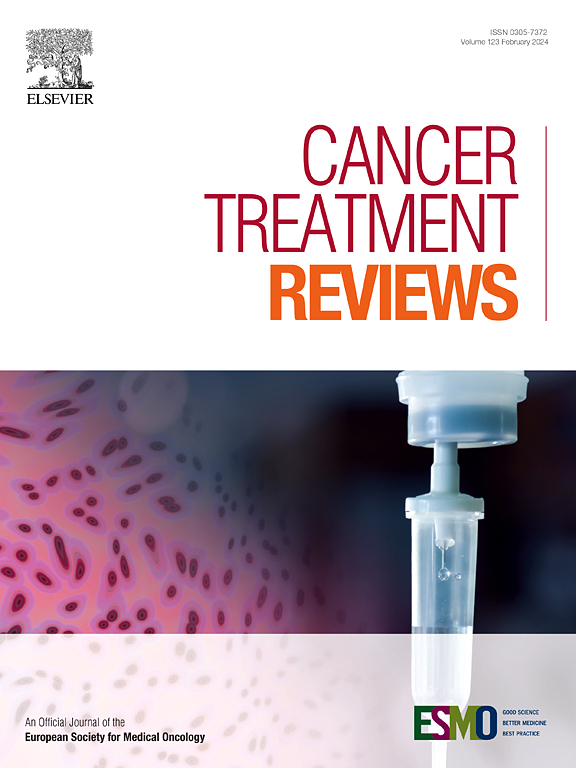乳腺癌患者心血管疾病风险的评估和分层:范围综述
IF 9.6
1区 医学
Q1 ONCOLOGY
引用次数: 0
摘要
乳腺癌患者患心血管疾病的风险增加,这通常与心脏毒性乳腺癌治疗或两种疾病之间重叠的危险因素有关。治疗前心血管风险评估可以实现准确的风险分层和预防心血管疾病。研究中已经提出、描述或使用了几种工具来评估基线(治疗前)风险,以确定在癌症治疗之前、期间和之后的适当心血管疾病护理。本综述旨在确定和描述乳腺癌患者基线心血管疾病风险评估工具的关键特征。方法检索2013年1月至2024年3月发表的文章,检索spubmed、Embase和谷歌Scholar,以确定报道乳腺癌患者心血管疾病风险评估工具的文章。出版物包括研究论文(观察性和实验性研究)和立场/政策、评论和评论论文。合格性评估和关键数据由两名审稿人独立提取。与作者团队讨论并解决了冲突。结果共鉴定出144篇。其中,57个报告了心血管疾病风险评估工具的开发、验证或建议的原始数据,87个报告了此类工具的使用情况。从这些文章中,确定了13种工具,用于评估诊断为乳腺癌的人患心血管疾病(n = 3)或因心血管疾病死亡(n = 1)的风险,或专门评估心脏毒性或心力衰竭(n = 8)或静脉血栓栓塞(n = 1)的风险。14种工具评估了被诊断为混合癌症类型(包括乳腺癌)的人患心血管疾病的风险。方案文件中描述了四种工具和(或)监测途径的计划开发。在所有确定的工具中(n = 31),有7个工具(其中4个工具仅评估诊断为乳腺癌的人)通过了外部验证,在将癌症患者有效地划分为风险类别方面表现不佳或中等。纳入评估工具的风险因素包括年龄、乳腺癌治疗类型和既往心血管疾病。虽然确定了关于基线心血管疾病风险评估的临床指南和建议,但这些指南和建议要么适用于广泛的癌症患者,要么适用于癌症治疗类型,而不是专门针对乳腺癌患者。结论确定了几种评估乳腺癌患者基线心血管疾病的工具,但只有7种工具经过了验证过程,而且没有一种工具被发现在根据基线心血管疾病风险区分人群方面非常有效。需要进一步的工作来优化乳腺癌患者基线心血管疾病风险评估的有效性,以便在治疗前、治疗期间和治疗后对风险进行适当的分层和监测,以改善心血管健康和预后。本文章由计算机程序翻译,如有差异,请以英文原文为准。

Assessment and stratification of cardiovascular disease risk in people diagnosed with breast cancer: A scoping review
Background
Breast cancer patients are at increased risk of cardiovascular disease, which often are associated with cardiotoxic breast cancer treatment or overlapping risk factors between the two diseases. Pre-treatment cardiovascular risk assessment can enable accurate risk stratification and prevention of cardiovascular disease. Several tools have been suggested, described or used in research to assess baseline (pre-treatment) risk to determine appropriate cardiovascular disease care before, during and after cancer treatment. This scoping review aims to identify and describe key features of baseline cardiovascular disease risk assessment tools for breast cancer patients.
Methods
PubMed, Embase and Google Scholar were searched for articles published January 2013 – March 2024 to identify publications reporting cardiovascular disease risk assessment tools in breast cancer patients. Publications included research articles (observational and experimental studies) and position/policy, commentary and review papers. Eligibility was assessed and key data were extracted independently by two reviewers. Conflicts were discussed and resolved with the authorship team.
Results
A total 144 articles were identified. Of these, 57 reported original data for the development, validation or recommendations of cardiovascular disease risk assessment tools and 87 reported the use of such tools. From these articles, 13 tools were identified that assessed the risk of cardiovascular disease broadly (n = 3) or death due to cardiovascular disease (n = 1) or specifically of cardiotoxicity or heart failure (n = 8) or venous thromboembolism (n = 1) in people diagnosed with breast cancer. Fourteen tools assessed cardiovascular disease risk in people diagnosed with mixed cancer types, including breast cancer. The planned development of four tools and/or surveillance pathways were described in protocol papers. Among all these tools identified (n = 31), seven tools (among these, four tools assessed people diagnosed with breast cancer only) went through external validation and performed poorly or moderately in stratifying cancer patients effectively into risk categories. Risk factors included in the assessment tools were age, breast cancer treatment type and pre-existing cardiovascular disease. While clinical guidelines and recommendations about baseline cardiovascular disease risk assessment were identified, these were either for cancer patients broadly or for cancer treatment types, and not specifically for people diagnosed with breast cancer.
Conclusion
Several tools to assess baseline cardiovascular disease in people diagnosed with breast cancer were identified but only seven tools had gone through a validation process, and none were found to be very effective in differentiating people by baseline cardiovascular disease risk. Further work is needed to optimise the effectiveness of baseline cardiovascular disease risk assessments for breast cancer patients to enable appropriate stratification and monitoring of risk before, during and after treatment to improve cardiovascular health and outcomes.
求助全文
通过发布文献求助,成功后即可免费获取论文全文。
去求助
来源期刊

Cancer treatment reviews
医学-肿瘤学
CiteScore
21.40
自引率
0.80%
发文量
109
审稿时长
13 days
期刊介绍:
Cancer Treatment Reviews
Journal Overview:
International journal focused on developments in cancer treatment research
Publishes state-of-the-art, authoritative reviews to keep clinicians and researchers informed
Regular Sections in Each Issue:
Comments on Controversy
Tumor Reviews
Anti-tumor Treatments
New Drugs
Complications of Treatment
General and Supportive Care
Laboratory/Clinic Interface
Submission and Editorial System:
Online submission and editorial system for Cancer Treatment Reviews
 求助内容:
求助内容: 应助结果提醒方式:
应助结果提醒方式:


